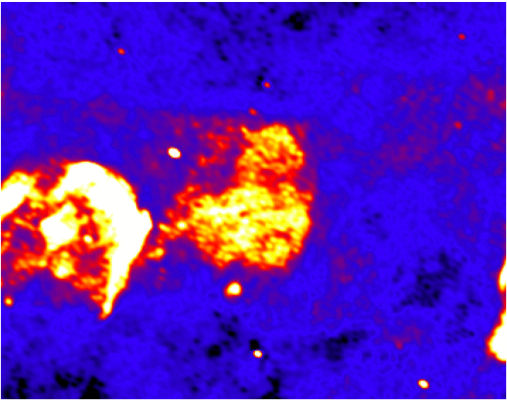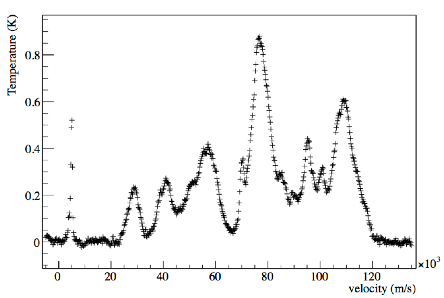Emission from the region of SNR G22.7-0.2
May 2012

Radio observations of the region around 23 degr. Galactic Longitude (Helfand et al. 2006) reveal two supernova remnants, G22.7-0.2 and G23.3-0.3 (W41), see top image. The distance to G23.3-0.3 is about 4 kpc, the distance of G22.7-0.2 is unknown. Infrared observations using the Spitzer observatory (Reach et al. 2006) show enhanced infrared emission between G22.7-0.2 and G23.3-0.3, which might be interpreted as an interaction between the two remnants and would place them at similar distance.
Situated near the Galactic plane in a field of view rich in gamma-ray sources, evidence for a new VHE gamma-ray source was found thanks to observations dedicated to the study of neighbouring sources, such as G23.3-0.3/W41 which is bright in VHE gamma-rays (SOM June 2006). In 50 h of H.E.S.S. data, a faint gamma-ray signal - HESS J1832-093 - emerges from a location on the rim of G22.7-0.2, with a (pre-trials) significance of about 6 standard deviations and a flux of about 0.7% of the flux from the Crab Nebula (Fig. 1). The source is located at longitude 22.48 degr. and latitude -0.16 degr. and there is a hint that the source may be extended.
A possible orgin of the gamma ray emission could be the interaction of cosmic rays accelerated in the remnant with clouds of interstellar gas, via neutral pion production and decay. Such gas should be visible in its radio CO line emission. The Galactic Ring Survey (GRS) performed with the Boston University FCRAO telescopes (Jackson et al. 2006) provides measurements of the 13CO (J=1->0) transition line in this region. Fig. 2 shows the 13CO line intensity observed around the position of the gamma ray emission, as a function of the radial velocity of the gas, which reflects gas motion due to the rotation of the Galaxy and allows estimation of the distance of the gas. Several molecular clouds are found in this region, evident as peaks in the CO emission at specific velocities. The molecular clouds that are most spatially coincident with the gamma-ray source are at velocities of 28 km/s and 77 km/s; the corresponding 13CO images are reproduced in Fig. 3. Given our position in the galaxy, two distances are possible for each velocity. Cloud (a) could be at 3.2 or 13.8 kpc distance, and cloud (b) at 4.8 or 10.5 kpc. For the 'near' solutions - in the range of the estimated distance of the remnants - derived cloud masses range between 1000 and a few 10000 solar masses. Energetically, a release of about 10^50 ergs in cosmic rays, as usually assumed for supernova remants, would be ample to explain the gamma ray luminosity as due to cosmic-ray interactions in these clouds, at least for the near distances.
Reference: "Evidence for VHE emission from SNR G22.7-0.2 region with H.E.S.S", H.E.S.S. collaboration, H. Laffon et al., arXiv:1105.5114 and Proc. of the 2011 Fermi Symposium - eConf C110509


